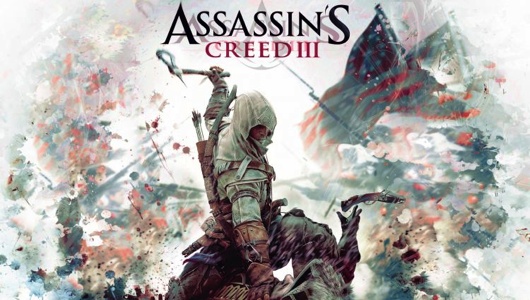Assassin’s Creed III is, without a doubt, one of the most highly anticipated titles of the year; it’s also one of the most controversial if you live on my side of the pond. So does the game manage to weave a deft, deep and involving experience or does it do a hatchet job and go the route of US High School history classes and become overly obsessed with dispatching tea-quaffing limeys?
• Developer: Ubisoft Montreal
• Publisher: Ubisoft
• Reviewed on: Xbox 360
• Also Available On: PlayStation 3, PC, Wii U
• Release Date: 360/PS3: Available now, PC: November 20th (US) / November 23rd (EU), Wii U: November 18th (US) / November 30th (EU)
One of the most difficult aspects of reviewing Assassin’s Creed III is the considerable risk of inadvertently letting a spolier slip. I will do my very best to keep the sanctity of your Creed-fulfilling experience as spotless as Ezio’s spanking white robes, but if you really want every aspect of the game to remain incognito (OK, my analogies are already being stretched a bit thin), you might want to stop reading now. Because Assassin’s Creed III throws a good couple of curveballs at you during your jaunt through revolutionary America – and there’s a very good reason why there’s an exceptionally aptly named achievement called ‘How D’you Like Them Apples?’. Z and, may I venture, OMG.
Assassin’s Creed III is set in the period of the American Revolution, where a ragtag band of plucky Colonists pulled themselves together in the name of Liberty and gave those pesky, tax-hungry Brits the boot back across the pond. All joking aside, we were a tad insufferable back then, and pretty much deserved what we got. Now that that particular slice of humble pie has been washed down with a cup of Earl Grey, I’ll crack on with the rest of the review.
Historically speaking, the American Revolution is an exceptionally interesting period to have as a backdrop to the events of Assassin’s Creed III and the escalating tensions between the Colonists and the Brits is played on to excellent effect in the game’s story. At first glance, the setting of Assassin’s Creed III seems not as well-suited to the religious undertones of the age-old tale of strife between the Assassins and the Templars – certainly in comparison to the Crusades and the skullduggery of the Borgia family in Renaissance Rome.
I’ll admit that I was a bit skeptical about how well the Revolution would suit the Templars vs. Assassins story, but boy, was I wrong. In Assassin’s Creed III, the Templars are wonderfully mercurial, fleetingly pledging their allegiances, playing one side off against the other and, ultimately, keeping their eyes focused on their own, self-serving interests no matter the cost to others. In stark contrast, the Assassins’ influence has very much waned in Colonial America and, in some ways, have become isolated and are forced to reinvent themselves to continue fighting the good fight against the control-hungry Templars.
Connor, the half-American Indian protagonist of Assassin’s Creed III, finds himself stuck between the two sides of the Revolutionary War, ever-aware that the indigenous inhabitants of the frontier are caught in the crossfire between two warring nations, virtually powerless to affect the fate of their native lands against the tide of the Revolution. The necessary cynicism and distrust of Brits and Colonial figureheads that Connor has had to develop in the face of the Revolution is wonderfully played upon in the story of Assassin’s Creed III, confounding any preconceptions you may have had with respect to who is cast as the archetypal ‘good guys’ or ‘bad guys’. Like any war, determining which side has the moral high ground very much depends on your point of view – and Connor rightly sees threats lurking beneath the Star Spangled Banner and Union Jack alike.
The world in which the Revolution plays out is truly sumptuous; graphically, Assassin’s Creed III stands head and shoulders above the rest of the games in the series. The Revolutionary-era cities of New York and Boston are beautifully realised, chock-full of wonderful details that change as the Revolution progresses, that make the virtual world of 18th Century America all the more compelling. The woods of the frontier, which could have stood out like a sore thumb in graphical terms, look verdant and lush and serve as a wonderfully inviting playground for a budding Assassin to navigate around.
But the Assassin’s Creed series has never just been about the plight of Assassins from the days of yore – the narrative backdrop behind each and every one of the games of the series has followed Desmond Miles in his own personal quest to smite the Templars, have an awkward man-hug with his Dad and decipher the machinations of the ‘First Civilisation’. The present day storyline picks up where Revelations left off – with the end of the world looming, the Assassins on the run and Juno (the self-appointed voice of the First Civilisation) promising Desmond the answers to four games worth of cliffhangers.
In Assassin’s Creed III, the modern day storyline seems a lot less involved and convoluted compared to previous instalments, seemingly attempting to tie up the disparate loose ends from earlier games rather than adding to the air of mystery and intrigue that seemed to be the main trope of Desmond’s side of the story. That’s not to say that Desmond’s tale in Assassin’s Creed III doesn’t bring anything to the table, mind you. Much like Connor, his ancestor, you get the impression that he finds himself caught between the wishes of two entities – but in Desmond’s case, it’s his Dad, the de facto voice of the Assassins in the 21st Century, and the mysterious ulterior motives of Juno.
The story of Assassin’s Creed III is, without doubt, ambitious – and its execution is pretty much pitch-perfect, full of mystery, intrigue, double-crossing and wonderfully crafted characterisation. So does the gameplay match up to the lush backdrop afforded to it by the storytelling of this game? Largely, yes; but akin to generations upon generations of assassin Animus avatars, its footing does occasionally falter.
The controls of Assassin’s Creed III have been reworked from the ground up, with the primary aim of simplifying how you interact with the world around you – anyone who’s played any of the previous Assassin’s Creed games will have endured hand cramp-inducing controller contortionism whilst attempting to get your assassin doing what you want them to do. Thankfully, those days are a thing of the past – free running now merely requires some feathering of the right trigger, for example. Combat has also been simplified, feeling much more fluid and engaging as a result – and, if you can read the movements of nearby Redcoats in time, you can even shield yourself from incoming gunfire by pulling an unwitting enemy in front of you.
Sadly, these moments of effortless – and wonderfully savage – grace are interspersed by moments of unintentional cackhand – or foot – edness as Connor happily perches himself on top of a crate instead of chasing a Templar down. For any long time fans of the series, such foibles shouldn’t come as too much of a surprise – and for the majority of the game, bar one chase sequence near the end of the game, this isn’t too much of an issue.
Despite this minor grumble, one of the most pleasant surprises is the relative ease with which you’re able to traverse the lush woodlands to be found in the frontier. I was anticipating that the free running nature of the game to come a little unstuck when faced with this decidedly non-urban environment but, once I got my eye in with respect to what bits of foliage could be scrambled up, I was happily bounding around the trees like a mildly deranged – albeit very well co-ordinated – baboon.
The woods of the frontier also bring with them new opportunities and dangers – there’s animals to hunt and animals to be hunted by. The bounties to be gleaned from the forest can be sold on and represent the backbone of Connor’s income, but there’s a real element of trading off the risks against the rewards; the fur of a bear fetches more money than a hare, but a bear is much more likely to decide that you’re lunch. Mind you, if you get eaten by a bunny rabbit, you’re clearly not cut out for life in the wilderness.
Another departure from the norm of the series in Assassin’s Creed III is the introduction of naval combat. It’s not the first time that a game in the Assassin’s Creed series has chucked a new mechanic into the mix – such as the lamentable tower defence sections of Revelations – but setting sail on the high seas is an absolute joy and a genuine high point of Assassin’s Creed III. Unleashing a broadside against an enemy ship and seeing it explode into a flaming shower of splinters is hugely satisfying; the fact that you need to position your ship to take advantage of the swells of the sea and wind direction whilst avoiding outcrops of rock make landing a perfect volley of cannonballs all the more rewarding.
Multiplayer, introduced in Brotherhood and Revelations, makes a welcome return in Assassin’s Creed III, expanding on what was already a great addition to the franchise. There’s a couple of new modes this time around, with modes such as ‘Domination’ (essentially ‘King of The Hill’ with sneaky stabby stabby action) and a new co-op mode called ‘Wolfpack’ that charges your team with dispatching as many targets as possible within a time limit. Just about everything you do in multiplayer earns you XP, allowing you to unlock myriad customisations for your character and profile. There’s also a self-contained story that unlocks chapter by chapter as you level up – this, combined with the fact that multiplayer in Assassin’s Creed encourages you to outthink rather than outgun your opponents will keep you coming back for more. If that wasn’t enough, the addition of challenges, loadouts and the promise of forthcoming clan support should give multiplayer some serious long-term appeal in the coming months.
All in all, this is an excellent addition to the Assassin’s Creed series and will keep fans of the franchise happy for many, many hours. There’s a great deal of variety on offer in Assassin’s Creed III and even when you’ve finished off the main story, there’s plenty more shiny things to collect, weapons to unlock and mysteries to unravel than you can shake a tomahawk at.










PacManPolarBear
Revelations brought me back to the series. I’m so happy AC3 turned out really good. Between this and Liberation they have really made a fan again.
Mike
I am loving it so far… though I can’t figure out how to beat the current mission I’m on. The “How d’ya like them apples” trophy was kind of a “whaaaaaaaat” moment, though I did guess it a little while before it happened. Still, awesome twist!
Kev
It’s just unfortunate that five games in they’re still dishing out a 5-hour tutorial. Also, the idiosyncratic controls are just as messy as they’ve always been, even the hot new feature ‘you can no longer run off of ledges accidentally’ fails occasionally. And don’t even get me started on the frame-rate issues on consoles. Or the endless running on a single plane.
Other than those points, I’m enjoying it pretty thoroughly!